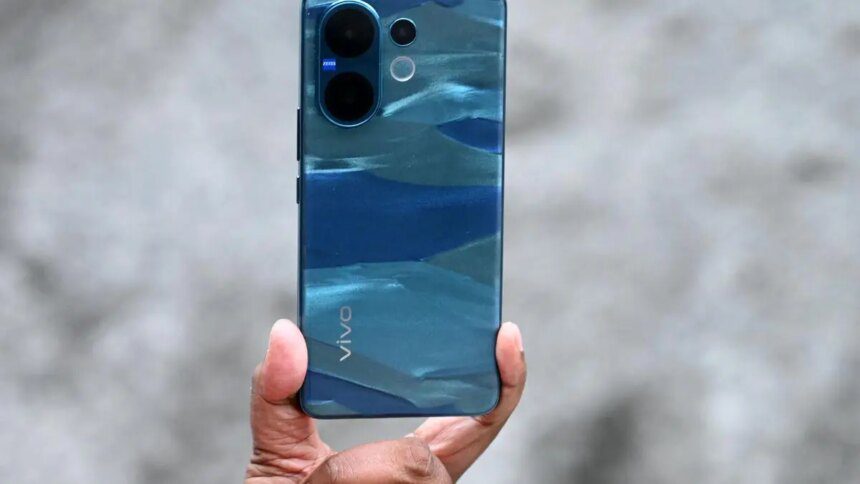Vivo’s V series has long struck a balance between everyday usability and camera-centric innovation. But with the new Vivo V60, that balance tips intriguingly toward the premium side. Despite being the “vanilla” model compared to the pro-lineup by the brand, this year’s V60 feels anything but basic — from its edge-to-edge design and ZEISS-tuned optics to a display that dazzles even in harsh sunlight. After putting it through its paces for over a week, here’s how this understated performer fared in real-world use.
Design
The design is one of the talking points, thanks to its edge-to-edge display with no screen real estate wasted. The phone measures a slim 16.353 × 7.696 × 0.775 cm and is easily pocketable at 201 grams. My review unit is the ‘Moonlit Blue’ which has ocean-wave-like motifs on the back glass panel, almost lending a three-dimensional effect when held against the light.
The Vivo V60 brings the pill-shaped camera bump of the X200 FE, which houses the Zeiss-tuned 50 MP super-telephoto and main camera. This design choice makes the device a bit wobbly when placed against a flat table surface.
Display
The Vivo V60 sports a 6.77-inch AMOLED display featuring a 2392×1080 pixel resolution. The screen supports capacitive multi-touch and offers 60 Hz and 120 Hz refresh rates. Delivering up to 5,000 nits of local peak brightness and covering the P3 wide colour gamut, the display allows for great visuals to be consumed on it. Nevertheless, its large, thin form factor could make one-handed grip difficult, specifically when attempting to pull down the quick settings panel.
The display’s bright, vibrant colours and excellent daytime legibility—a direct result of the 5,000-nit peak brightness—were great right out of the box. This quality made watching demanding visual content a pleasure. The edgeless display rendered the rich colours of anime, such as Demon Slayer: Kimetsu no Yaiba, extremely well. It also handled the urban locations and skin tones in films such as Odum Kuthira Chadum Kuthira (2025) on Netflix with good contrast and fidelity.
The Vivo V60 uses a dual speaker setup. Though the sound was loud enough, the overall acoustic quality was average. The audio lacked depth, making vocals sound flat. This limitation meant the phone isn’t a top-tier multimedia device despite its excellent screen.
The Vivo V60 is powered by the Snapdragon 7 Gen 4 processor, which features an eight-core CPU built on a 4 nm process | Photo Credit: Bijoy Ghosh
Performance
The Vivo V60 is powered by the Snapdragon 7 Gen 4 processor, which features an eight-core CPU built on a 4 nm process. The unit I reviewed came equipped with 12 GB of RAM and 256 GB of storage. Other available configurations include 8 GB+128 GB, 8 GB+256 GB, and 16 GB+512 GB options.
In the GeekBench 6 benchmark, the device scored 1,198 in the single-core segment and 3,435 in the multi-core segment, placing it just below the OnePlus 11R, which uses the Snapdragon 8+ Gen 1.
Benchmarking results aside, the phone felt very responsive in hand, exhibiting minimal lag or stutter while switching between apps and gaming. Even during intense gameplay in Shadow Warrior 4, the device managed the “crazy button bashing” without significant thermal issues, despite having a glass back.
The V60 runs on FunTouch OS 15, which is based on Android 15. The phone does come pre-loaded with bloatware, including games like Candy Crush, Block Blast, and DIY Fashion Queen, as well as Vivo’s proprietary suite of apps (app store, themes, browser, photos, etc). Fortunately, these can be either removed during the initial setup process or uninstalled afterward.
Camera
The Vivo V60 features an impressive ZEISS-tuned camera system. The rear array consists of a 50 MP ZEISS Main Camera (f/1.88, with OIS), a 50 MP ZEISS Super Telephoto Camera (f/2.65), and an 8 MP ZEISS Ultra-Wide Angle Camera (f/2.0). On the front, there is a high-resolution 50 MP ZEISS Group Selfie Camera (f/2.2).
The standout lens in this setup is the 50 MP ZEISS Super Telephoto Camera, which makes the V60 one of the best mid-range phones for portrait photography with good edge detection on human subjects, up to 3x zoom retains a fair amount of details, and post that the image starts becoming softer with loss of details.
The main camera also performs exceptionally well, retaining a high level of detail and excellent balance across highlights and shadows, solidifying the V60 as a capable photography contender in its segment.
The Vivo V60 cameras delivered excellent daylight performance, capturing images with robust detail and high contrast. However, its performance dipped significantly at night. Low-light shots were consistently average, with colour noise and a loss of fine detail in shadow areas.
The 50 MP ZEISS Group Selfie Camera was excellent, capturing natural and true-to-life skin tones with ample detail. The system’s only weak point is the 8 MP ultra-wide camera, which struggled with overall sharpness, exhibiting softness, especially around the corners. Overall, the ZEISS tuning provides a distinct and valuable quality addition to this smartphone’s camera experience.
Video recording was smooth, capable of shooting footage up to 4K, making this a robust and well-rounded camera setup overall.
Software features
AI is clearly a major focus, and its integration in the Vivo V60 appears on both the system level and within the native Photos app. At the system level, the Vivo V60 utilises AI to improve connectivity and communication. It features AI SuperLink, which works to boost weak signals and accelerate network reconnection, resulting in smoother calls and video streaming. Additionally, the AI Smart Call Assistant enhances utility by offering real-time call translation and generating smart call summaries in various languages. These system integrations all function smoothly and effectively.
Within the Photos app, the V60 offers a suite of AI-powered editing features, including AI Photo Enhance, AI Image Expander, AI Magic Move, AI Erase, and AI Reflection Remover. While these tools can be slow to process the image, the results are generally decent enough for quick sharing on social media.
Battery
The 6,500 mAh battery in the Vivo V60 delivers strong endurance for day-to-day use. With light to moderate usage including calls, clicking photos, reading emails, and more, the phone easily achieved a screen-on time of 7.5 hours, allowing it to last for nearly 1.5-2 days between charges.
The included 90W Flash charger provides extremely fast charging: a charge up to 50 per cent takes about 25 minutes, and a full charge is completed in under an hour. This speed means the device can reliably get enough charge to last the entire day before you head out in the morning.
Verdict
Priced at ₹45,999, the Vivo V60 feels slightly overpriced given the current market. While it faces stiff competition from rivals such as the Samsung Galaxy S24 FE and the OnePlus 13R, the V60 offers a standout package. Its great design, exceptional display, impressive main cameras, and decent overall multimedia experience are significant strengths. The few drawbacks—namely the sub-par ultra-wide lens and the bloatware in FunTouch OS, are minor issues that wouldn’t deter me from recommending this mobile phone.
Vivo V60
Price: ₹45,999
Pros: Great design, display, great camera
Cons: Sub-par ultrawide camera, bloatware in FunTouch OS
Published on October 8, 2025










